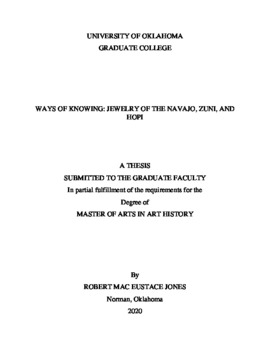| dc.contributor.advisor | Fields, Alison | |
| dc.contributor.author | Eustace Jones, Robert Mac | |
| dc.date.accessioned | 2020-05-06T21:05:39Z | |
| dc.date.available | 2020-05-06T21:05:39Z | |
| dc.date.issued | 2020-05 | |
| dc.identifier.uri | https://hdl.handle.net/11244/324296 | |
| dc.description.abstract | This research examines the introduction of Southwestern Native American jewelry as an art form in the Navajo, Zuni and Hopi cultures in conjunction with developing sociographic variables, supporting cultural survivance while resisting European colonization. It examines handmade pieces of jewelry made by members of Native American source communities, informed by their visual language and material culture, in the creation of flexible art objects that work to transmit knowledge, tradition and heritage. The primary focus of this research is to develop methods of artistic attribution utilizing social media sources as a direct link to the source communities. Im-portant works containing different levels of knowledge will no longer be operational if they lose their connection with their source of activation. By using a relationship matrix linked to a piece of jewelry’s movement through time and space, becoming the responsibility of different stew-ards, it became possible to access its link to its artistic origin.
First, by examining an artwork representing facets of the relationship between a Native American artist and their Tribal community, it is possible to access specific cultural information embedded in the work aside from cryptic knowledge meant only for specific cultural members. This research does not seek to understand the protected knowledge within a Native American art-object; however, it does seek to show the presence of the information allowing for the object to operate on multiple levels. Secondly, by examining the relationship between the piece of jewel-ry and its collector, we can see the piece’s flexibility not only as it operates as an object of cultur-al transmission but also as an artwork, a piece of fashion, and an item of identity for the collector who came upon it. Finally, as an art-object enters the stewardship of an institution, such as the Fred Jones Jr. Museum of Art, its knowledge may become available once again to its source community if the institution knows how to access its history. | en_US |
| dc.language | en_US | en_US |
| dc.subject | Silversmith | en_US |
| dc.subject | Native American | en_US |
| dc.subject | Southwestern Jewelry | en_US |
| dc.subject | Navajo Zuni Hopi | en_US |
| dc.subject.lcsh | Navajo Indians--Jewelry | |
| dc.subject.lcsh | Zuni Indians--Jewelry | |
| dc.subject.lcsh | Hopi Indians--Jewelry | |
| dc.subject.lcsh | Indians of North America--Jewelry--Social aspects--Southwest, New | |
| dc.title | WAYS OF KNOWING: JEWELRY OF THE NAVAJO, ZUNI, AND HOPI | en_US |
| dc.contributor.committeeMember | Bailey, Robert | |
| dc.contributor.committeeMember | Cobb-Greetham, Amanda | |
| dc.date.manuscript | 2020-03-03 | |
| dc.thesis.degree | Master of Arts in Art History | en_US |
| ou.group | Weitzenhoffer Family College of Fine Arts::School of Visual Arts | en_US |
| shareok.orcid | 0000-0002-5525-3991 | en_US |
| shareok.nativefileaccess | restricted | en_US |
